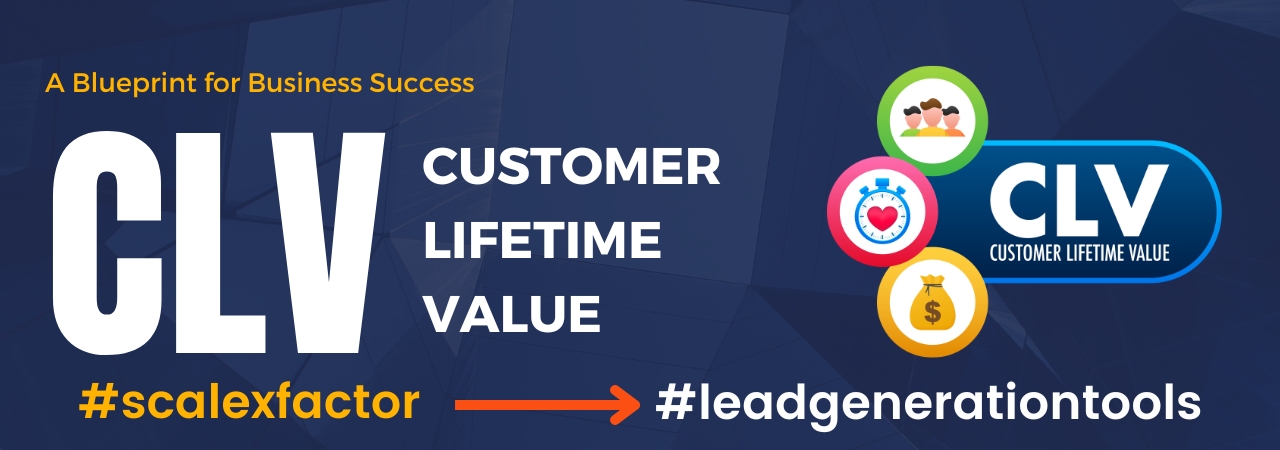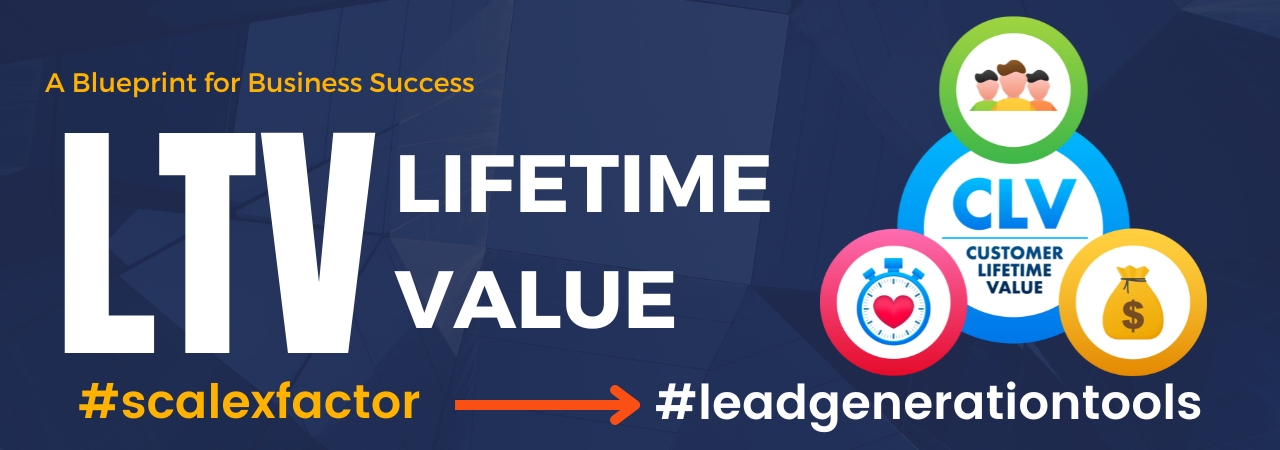Customer Lifetime Value (CLV): An In-depth Explanation with Examples
Introduction: Customer Lifetime Value (CLV), also known as Lifetime Value (LTV), is a critical metric in marketing and business that helps companies understand the total value a customer brings over their entire relationship with the company. It quantifies the net profit generated from a customer throughout their engagement with the business, considering factors like purchase frequency, average order value, and customer retention.

Lets understanding and harnessing the power of Customer Lifetime Value (CLV), also referred to as Life Time Value (LTV), is a cornerstone of strategic business management. CLV illuminates the intricate dynamics of customer relationships, providing invaluable insights into the long-term worth a customer brings to a company. By delving into how to calculate this metric through a specific formula that considers aspects like average purchase value, purchase frequency, and customer lifespan, businesses can navigate the customer journey with precision, enhance customer success, and effectively increase the overall value they derive from their customer base.

This comprehensive approach to evaluating customer relationships not only refines marketing strategies and product development but also empowers enterprises to foster stronger connections, elevate customer satisfaction, and ultimately, optimize their bottom line.
Calculation of CLV: The CLV calculation generally involves three main components: Average Purchase Value, Purchase Frequency, and Customer Lifespan.
CLV = Average Purchase Value × Purchase Frequency × Customer Lifespan
- Average Purchase Value: This is the average amount of money a customer spends on each purchase. It can be calculated by dividing the total revenue generated from all purchases by the total number of purchases.
- Purchase Frequency: This represents how often a customer makes a purchase within a specific time frame. It’s calculated by dividing the total number of purchases by the total number of customers.
- Customer Lifespan: This is the average duration a customer stays engaged with the business. It can be calculated by adding up the time periods each customer has been active and dividing it by the total number of customers.
Examples:
Let’s walk through a couple of examples to illustrate how CLV works.
Example 1 – E-commerce Store:
Suppose you run an online clothing store. On average, a customer spends $50 per purchase, makes 4 purchases per year, and remains a customer for 3 years.
Average Purchase Value = $50 Purchase Frequency = 4 purchases/year Customer Lifespan = 3 years
CLV = $50 × 4 × 3 = $600
In this case, the CLV of a customer is $600.
Example 2 – Subscription-based Service:
Consider a software company that offers a subscription-based project management tool. The monthly subscription fee is $30, and customers tend to stay subscribed for an average of 2 years. On average, each customer refers two new customers within the first year.
Average Purchase Value = $30 (monthly subscription) Purchase Frequency = 12 months/year Customer Lifespan = 2 years
CLV = $30 × 12 × 2 = $720
Additionally, the referral effect can be factored in:
Referral Customers = 2 Average CLV from Referrals = $720
Total CLV = CLV + (Referral Customers × Average CLV from Referrals) Total CLV = $720 + (2 × $720) = $2160
Thus, the CLV of a customer, considering the referral effect, is $2160.
Importance of CLV:
- Strategic Decision Making: Understanding CLV helps businesses allocate resources effectively by focusing on high-value customer segments.
- Marketing Budget Allocation: CLV aids in optimizing marketing budgets by prioritizing customer acquisition and retention strategies.
- Customer Segmentation: Businesses can categorize customers based on their CLV, tailoring marketing efforts to different segments.
- Product Development: CLV insights can guide product development, leading to offerings that resonate with high-value customers.
- Profit Maximization: By enhancing customer retention and satisfaction, CLV contributes to long-term profitability.
Where customer relationships are the lifeblood of sustained growth, understanding the concept of Customer Lifetime Value (CLV) has emerged as a pivotal driver of success. CLV transcends the transactional nature of a single purchase, offering a holistic view of a customer’s value throughout their journey with a company. This article delves deep into the significance of CLV as a potent blueprint for achieving long-term business success.
What is Customer Lifetime Value (CLV)?
Customer Lifetime Value, often abbreviated as CLV or LTV (Lifetime Value), quantifies the economic value a customer generates for a business over the entirety of their engagement. It considers various factors such as the average purchase value, frequency of purchases, and the duration of the customer’s relationship with the company. In essence, CLV paints a comprehensive picture of a customer’s worth beyond a single transaction, enabling businesses to make informed decisions to nurture, retain, and maximize the value of their customer base.
The CLV Formula: A Deeper Dive
At the heart of CLV lies a simple yet powerful formula:
CLV = Average Purchase Value × Purchase Frequency × Customer Lifespan
- Average Purchase Value: This represents the average amount a customer spends in a single transaction. It reflects the quality of products or services offered by a business and their ability to meet customer needs.
- Purchase Frequency: This measures how often a customer makes purchases within a given timeframe. A higher purchase frequency indicates a deeper engagement and loyalty.
- Customer Lifespan: The duration a customer remains active with a company is a crucial component. A longer customer lifespan signifies strong customer relationships and effective retention strategies.
Strategies for Harnessing CLV:
- Segmentation and Targeting: CLV allows businesses to segment their customer base according to value tiers. This enables personalized marketing strategies tailored to each segment’s preferences and needs.
- Customer Retention: Identifying high CLV customers enables proactive retention efforts, including loyalty programs, personalized communications, and exceptional customer service.
- Marketing Allocation: By allocating resources based on CLV, businesses can optimize their marketing budget by focusing on high-value customer segments.
- Product Development: CLV insights guide product and service enhancements that cater to the preferences of high-value customers, fostering brand loyalty.
The CLV-Customer Success Nexus:
Customer success is at the heart of CLV. As businesses prioritize customer satisfaction, provide value-added experiences, and effectively address pain points, they extend the customer lifespan and increase CLV. The symbiotic relationship between CLV and customer success reinforces the foundation of business prosperity.
Customer Lifetime Value (CLV) – Maximizing Business Worth through Customer Relationships
Customer Lifetime Value (CLV), also known as Lifetime Value (LTV), is a crucial concept in business that gauges the long-term value a customer brings to a company. It’s like a crystal ball into a customer’s journey, revealing how much they contribute over their engagement with a brand.
Calculating CLV: To calculate CLV, consider three key factors: Average Purchase Value, Purchase Frequency, and Customer Lifespan.
CLV Formula: CLV = Average Purchase Value × Purchase Frequency × Customer Lifespan
1. Average Purchase Value: This is how much a customer spends on average in each purchase.
2. Purchase Frequency: It’s how often a customer buys from the company.
3. Customer Lifespan: This represents the duration a customer stays loyal to the brand.
Why CLV Matters: Imagine you have an online store. If a customer typically spends $50 per purchase, shops four times a year, and stays with you for three years, their CLV would be $600. This helps you know the customer’s worth and make decisions accordingly.
Utilizing CLV:
1. Strengthen Customer Relationships: By understanding CLV, you can focus on nurturing long-lasting connections with high CLV customers.
2. Boosting Customer Success: Enhancing customer satisfaction and solving their problems can increase their CLV.
3. Tailored Marketing: CLV guides targeted marketing strategies towards different customer segments based on their potential value.
4. Investment Allocation: Allocate resources wisely by identifying which customer segments are more valuable in the long run.
5. Product Development: Shape products and services that cater to high CLV customers’ preferences, driving more value.
6. Increasing CLV: To increase CLV, focus on improving customer experiences, offering loyalty programs, and maintaining communication throughout their journey.
Conclusion:
Customer Lifetime Value is a powerful metric that enables businesses to make informed decisions about customer acquisition, retention, and overall strategy. By analyzing CLV, companies can foster customer-centric approaches, enhance profitability, and build lasting relationships with their clientele.




